
|   |

|   |
17th Guru Debaprasad Das Award Festival - Dr.Nita Vidyarthi e-mail: nitavidyarthi@gmail.com Photos courtesy: Tridhara January 3, 2024 In the memory of Odissi Guru Debaprasad Das, artistes with an outstanding contribution in the field of performing arts are honoured each year with the award in his name by Tridhara, Bhubaneswar, an institution founded by the legendary Guru for the propagation, training and preservation of his style of Odissi dance. His worthy disciple Guru Dr. Gajendra Panda, principal custodian of the gharana and director of Tridhara, has toiled hard to keep the flag flying and extended the three-day annual festival of music and dance, to a successful and grand five day one from this year onwards (Oct 26-30). Celebrated on the maestro's birth anniversary every year, the annual award ceremony well into its 17th year, took off with its usual grandeur at the Rabindra Mandap, Bhubaneswar. The Guru Debaprasad Lifetime Achievement Award 2023 was presented to the renowned painter, sculptor and muralist Jatin Das. DAY 1 The first presentation of the inaugural evening was the group Odissi dance production 'Rama Kathamrutam' by the principal dancers of Tridhara based on some of the major episodes from Tulsidas's Ramcharitmanas. Guru Gajendra Panda created his own idiom of traditional dance, theatre and acting where the iconography of the performances schematized by him was successfully displayed by his dancers.  Tridhara ensemble The purpose of this traditional production was not to tell the story from beginning to end but to dwell on specific moments of the epic and focus on few scenes, with minutest details to evoke a sensation of truth. Prabhutosh Panda, a budding dancer, exhibited the responsibility to embellish the choreography and direction of his father and Guru with his own aesthetic contexts as Lord Rama and so did the other dancers imbibe principles of their Guru's direction without any departure at the significant points of the epic. The dancers entered performing with the Mangalacharan, a "Rama Dhyana" set to raag Abhiree and Madhyamadi by Guru Gopal Panda and continued to dance with the common sloka "Ramam Lakshmanam Purbajang Raghubharam Sitapati Sundaram" in Satyabrata Katha's imposing voice. This was followed by Sthayi (with a steady tune) set to raag Madhukiri. The swara of this number needs special attention. The tune was taken from the song "Jaya Jaya Raghupati Raghava Hey Rajibalochana" from Ravana Badha in Ramlila which Guru Gajendra Panda transformed into "Tamta thinda takuda dhikunda kukundarirenu taam thayee thayee"- a lovely number to watch. There were two parts of introducing the two principal characters of the epic to this segment. These were embellished with the characteristic Sabdaswara Patha of the Debaprasad Gharana in Guru Gajendra Panda's articulate diction. One was the 'Ram Parichay' (introduction of Rama by describing him): Bande pada padmajugala Shushobhita tanu megha shyamala Ajanulambita bahumrunala Gandeymandita manikundala Kandakudandadhari. 'Ravana Parichay' was pompously projected in Ravana's own proud declaration: Mu bishwabandana kulaja brahmana Subarna Lanka adishwara Kumbhakarna gajadhanapati anuja Mandodari praneshwara Mu tribhubanabijayee bingshopani. The last item of the production, ushered in by a fine group presentation of Pallavi was the Odia Abhinaya - the grand Sita Swayamwara set to raag Ghanakesi. The music was composed by Gopal Chandra Panda, rhythm composition by Sachidananda Das and the dance was choreographed by Gajendra Kumar Panda. A rare song, "Dhanu dharantey korey raghumani, kampey dharani" for the stringing of the bow at the Swayamwara was adapted from Daskathia. Immortalised by the renowned Daskathia singer Bajranath Das Sharma, it was selected by Guru Gajendra Panda as the final number. The choreography was replete with shringar, veer and adhbhuta rasa with some memorable moments like the celebration of the coronation of Rama, Sita Swayamwara, wedding, Sita Haran, crossing the sea on a boat and the building of the bridge with pebbles across the sea by the monkey brigade. Charming, chiselled, fluid and graceful bhangis, anga bhramaris like angabalayita and kshiptaabartita by the dancers enlivened by the elements of jumps like Chouka Utplavana and Chouka Ekpada Utplavana especially by Prabhutosh Panda were the stunning signature styles of Guru Gajendra Panda's choreography, characterised by intense focus on Sabdaswara Patha and technical virtuosity. All these distinctively evoked rasa. Presented with stunning dance sequences, both delicate and dynamic, some captivating theatrical imagery, without character costumes, and vibrant traditional singing by Sangita Panda, 'Rama Kathamrutam' was an enchanting telling of the time of Ramayana through dance. 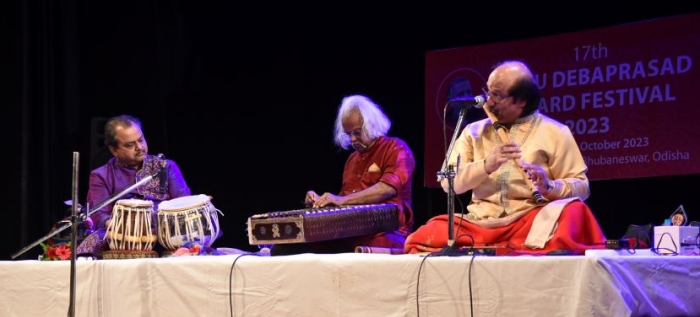 Pt Prosenjit Poddar, Pt Tarun Bhattacharya, Pt Ronu Majumdar The evening closed with a trio musical presentation of santoor by Pt Tarun Bhattacharya, flute by Pt Ronu Majumdar and tabla by Pt Prosenjit Poddar. According to the santoor maestro, their combined approach to raag Hamsadwani which they presented was "Sakaratmak and offered positive vibes". The short alaap and the two bandishes presented in Jhaptaal and Teentaal set to the sweet melodious raag was highly relished by the audience. DAY 2 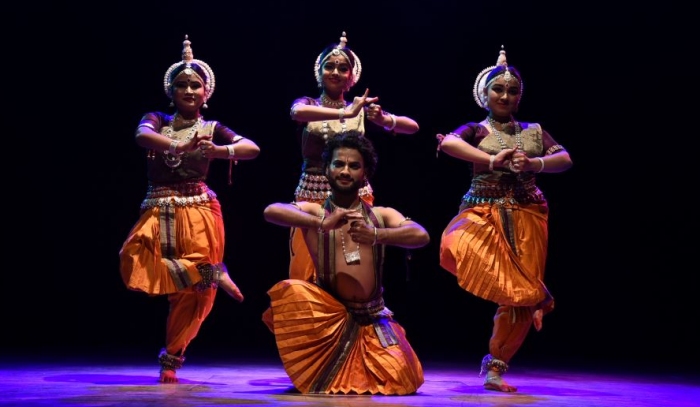 Sonali Mohapatra's group Sonali Mohapatra was unable to open the evening with her Odissi recital due to indisposition. Instead her disciples - a group of three females and one male - took to stage as representative dancers to present a riveting "Hanuman Chalisa" in the Odissi idiom, choreographed by Sonali with music by flautist Abhiram Nanda. The nritta portion covered most part of the choreography sprinkled with a couple of fine geometric formations set to variable rhythms and was neatly executed by the well-trained dancers. The later part of the evening was one of a delightful hearing pleasure for the appearance of three master musicians displaying their individual dazzling traditional compositions for the wonderment of their listeners. 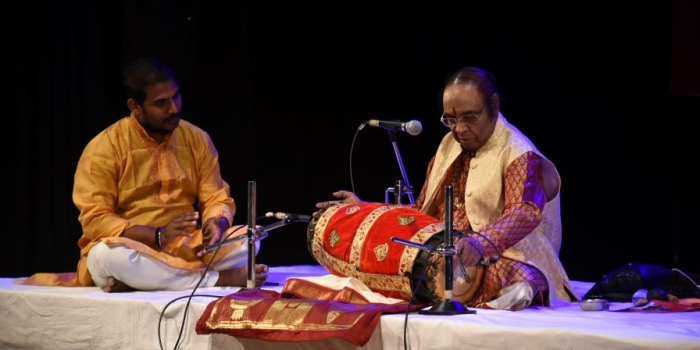 Yella Venkateswar Rao To hear the Carnatic mridangam maestro Yella Venkateswar Rao was an experience of a lifetime. With his utterance of "Hara Hara Mahadev" the mood was set for a spiritual journey through the thoughtfully selected soul-stirring compositions. He astonished the listeners by displaying his incredible musical depth with the rolling of the mridangam vibrating strongly with the 'Omkar Bani' and Chaturasra jati matya talam with lightly moving fingers. The audience was requested to clap with the talam of different weights and designs of playing from very low to aggressive, creating the charged flavour to reverberate in the auditorium. A tremendously gratifying experience indeed.  Rohen Bose, Manoj Kedia, Mormukut Kedia The second evening concluded with a sitar and sarod Jugalbandi by the renowned Kedia Brothers from Jharkhand. The twins of the Senia-Maihar gharana, Pt Manoj Kedia on the sarod and Pt Mormukut on the sitar interpreted the sweet romantic raga Majh Khamaj. The raga interpretation was done in definite terms exploring the strong and subtle nuances. Pt Manoj Kedia's heavy sombre strokes of sarod blended seamlessly with the tender stringing of Pt Mormukut's sitar from a chota alaap's slow moving notes of meend laden phrases and emotive blends of the vilambit to drut. Their creative talents sparkled in their amazing performance and their mutual understanding. Performing without even looking at each other or a cue was the hallmark of their duet. They won the hearts of the audience with the rendering of the touching bhajan "Vaishnava jana tho" of Narsinh Mehta, a favourite of Gandhiji. Young brilliant tabalia Rohen Bose trained under tabla stalwarts - his father Pt Debojyoti Bose and Pt Kumar Bose - was at his accompanying best as a part of the telling presentation. DAY 3  Bagmishree Das As always, Guru Debaprasad Das' granddaughter Bagmishree Das, by now an established Odissi dancer, opened the third evening with her solo recital. She commenced with the ritualistic Mangalacharan "Ganesh Bandana" from Laxmi Nrusingha Dhyana set to raag Mangalagujari and Lalita with the music composition of Pt Gopal Chandra Panda set to rhythm by the acclaimed guru Banamali Maharana and dance choreographed by Guru Gajendra Panda. She followed it by 'Navarasa' in Guru Gajendra Panda's choreography, originally choreographed by Guru Debaprasad Das in ragamalika and talamalika. Bagmishree proved her mettle of solid training with her technical prowess and abhinaya especially in karuna rasa with a vivid motif of feeding a bird and adbhuta rasa in construction of the bridge by monkey brigade. Buddhanath Swain was on the vocals and Srinibas Satpathy on the flute. 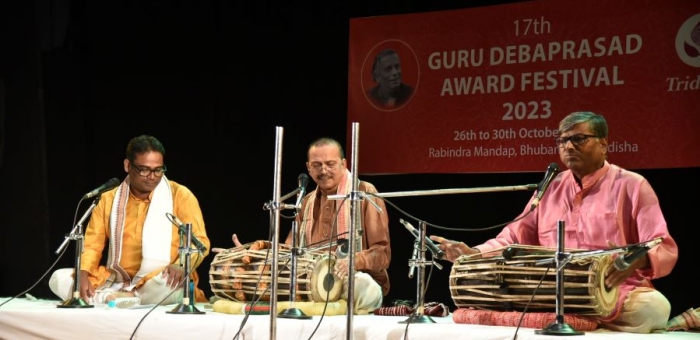 Pt Dhaneswar Swain & Pt Sachidananda Das In the musical segment, a very entertaining mardala duet recital by Pt Dhaneswar Swain and Pt Sachidananda Das with traditional Odissi music greeted the audience. Dhaneswar Swain has an immensely significant place in the musical history of India for his pioneering efforts in giving the mardala the place as a solo percussion instrument. The second to receive the Sangeet Natak Akademi Award for mardala in 2013, after his teacher Banamali Maharana, Swain was exhaustively trained under the late Pt Simhari Shyam Sunder Kar. Sachidananda Das, an equally versatile artiste, is also a popular rhythm composer for Odissi dance. The duet was based on different compositions in adi tala and tritala of 16 beats producing various layakaris with bols or ukutas in which they showcased Jamana (uthan), Chhanda Prakarana (similar to peshkar in tabla), then Ragada, Khandi, Badi and Arsasa. While Dhaneswar Swain concentrated on the subtlety, Sachidananda Das enthralled with the slightly aggressive rendition. Their solo renditions at times punctuated the duets to set aside any monotony if at all. It was a highly enjoyable performance for sure. A solo light classical vocal recital by Pt Siba Prasad Rath concluded the evening. With a good timbre in his voice, he sang some appealing traditional devotional and classical numbers where he showed his prowess on the elaboration and ornamentation of the ragas. However his presentation of ghazals was ordinary. DAY 4  Ileana Citaristi The evening took off with a soul-stirring solo performance by the thinking dancer Ileana Citaristi. Known for impactful thought provoking themes, the offering of the evening was 'Anyaaya' or injustice done on women. Ileana addresses this by citing the example of three famous characters from history and portraying the revenge taken by them against this injustice in different ways through her touching evocative abhinaya. The whole script was written in Sanskrit by Prafulla Kumar Mishra, narrated at the background of each piece set to music by Gopal Chandra Panda, soulfully sung by Sangita Panda in her strong impactful voice. Rhythm composition was by Sachidananda Das. Ileana chose Amba from Mahabharata as the first woman whose revenge for the injustice to her by Bishma was taken by transforming and reappearing through the character Shikhandi. This was a linear plot with the perfect portrayal of each character involved. In Medea from Greek mythology, the second analysis, Ileana puts forth vigorous hastas and foot movements to the kinetic phraseology to focus on the feminine power of Queen Medea – the ancient image of the queen as a revenger and child murderer. The dancer contrasted the character of Medea later by an unforgettable abhinaya as the healer, the mother and the tension that lies between the destructive and creative powers of the character - a high point of the whole presentation. Medea gets the credit of finding her place in Odissi presentation for the first time. 'Draupadi' was the last piece where the dancer was able to create rasa with her dance to do justice to the often performed story of Anyaaya in her own inimitable style. 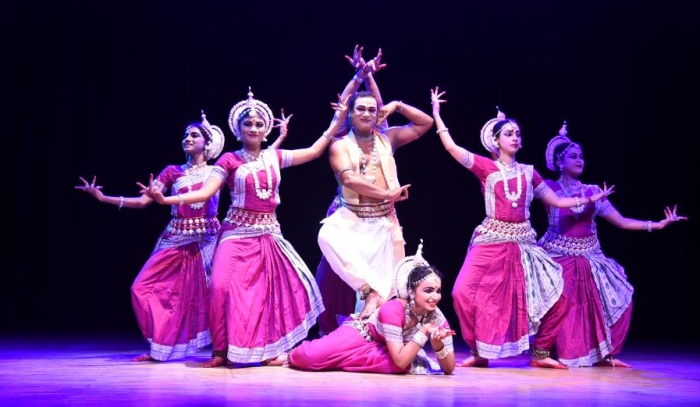 Kala Vikas Kendra ensemble The repertory group of Kala Vikas Kendra, Cuttack, presented 'Ganesh Vandana' and the story of the birth of Lord Ganesha through a well-coordinated neat dance presentation choreographed by Sudipta Panda and Guru Gajendra Panda. Five female and a male dancer began with "Jai bhabanandana sajjana bandana" and steered through the sabdaswara patha well. Enjoyable was the fight between Ganesh and Lord Shiva. 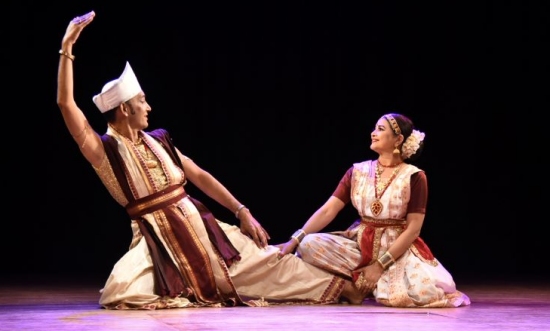 Ramkrishna Talukdar & Rumi Talukdar Acclaimed Guru Ramkrishna Talukdar and his dancer-wife Rumi Talukdar began their Sattriya presentation with the Guru Vandana "Karatala Kamala Kamala Nayana", a duet Vishnu Vandana in ektal, rupak and chutkala tala. Some sculpturesque postures like Ramkrishna as Vishnu in Anantasayana and Rumi as Lakshmi at his feet were appealing in the presentation. This was followed by a solo by Rumi set to a famous Borgeet "Sakhi pekho Madana Gopal" from the Ankiya Nat, Keligopal. A fine and graceful dancer, what unfolded from her mastery of style was a visual treat in all its rich and varied hues of aesthetic splendour. Draupadi by the duo was one of the most gratifying performances seen in recent times. The Vastraharan (disrobing of Draupadi) was highly imaginative with a very dignified performance as Duryodhana - aggressive dancing of Ramkrishna when the character demanded - who also doubled up as Krishna to be a saviour of Draupadi with swiftness. Facial expressions of the duo reflecting interplay of emotions, moods, feelings, anguish and finally relief were displayed with ease. The wrapping up and unwrapping of the Odhni (body cloth) around Rumi's waist was an imaginative and sober depiction of the Vastraharan of Draupadi. Another spellbinding performance. The long evening concluded with a much awaited vocal recital of traditional songs of Odisha by nine eminent singers. Because it was Kartik Purnima, bhajan style songs and devotional numbers on Sri Krishna were presented by seniors and junior singers. Popular music composer and singer Pt Laxmikant Palit opened the recital with "Thakiley hey Jamuna pani…" followed by young Anuja Tarini Mishra, now the administrator of GKMORC, with the ashtapadi "Nindati chandana". Other young singers were Satya Siddhant with "Prabhu Madana Mohana" and Sangita Panda with the favourite Gopal Krishna number "Mohana madhuri dekhithila nari". Octogenarian Prabhakar Srichandan presented a Guru Vandana and the very familiar "Monima Sunima". Guru Keshav Chandra Rout sang a popular number "Chatra chatra re bandu" and Sukanta Kundu "Kadambataru muley murali bajao". Others who enthralled were Satyabrata Sahu, and Dr. Sangita Gosain with "Prana mitoni re dekhiley..." simultaneously compering the programme. Sachidananda Das on the mardala and Abhiram Nanda on the flute were strong musical support among others. DAY 5 The concluding evening commenced with the presentation of the Guru Debaprasad Award 2023 presented to Ileana Citaristi (Odissi); Kamalini Asthana and Nalini Asthana (Kathak); Prathibha Prahlad (Bharatanatyam) and Guru Ramakrishna Talukdar (Sattriya). Guru Debaprasad Yuva Prativa Award 2023 was presented to Sonali Mohapatra (Odissi) and Dipika Priyadarsini (Odissi).  Prathibha Prahlad After the award ceremony, Prathibha Prahlad commenced her solo Bharatanatyam recital with a thunderous "Om Namah Shivaya" remembering the Yogi Vilasam Maheswaraya. Her entry was for the Shiva Stuti "Brihadiswara Mahadev" embracing both exquisite nritta and abhinaya set to ragam Kanada and rupaka talam where her stamina and expressional resources came to the fore in its entire intensity. Next followed the Jayadeva ashtapadi "Natha hare" sung by Pustakam Rama, where she captured the nuances of the beautiful lyrics. Replete with shringara was "Pashyati dishi dishi" with heightened abhinaya in the latter part of this piece. The music composition was by Dr. M. Balamuralikrishna. 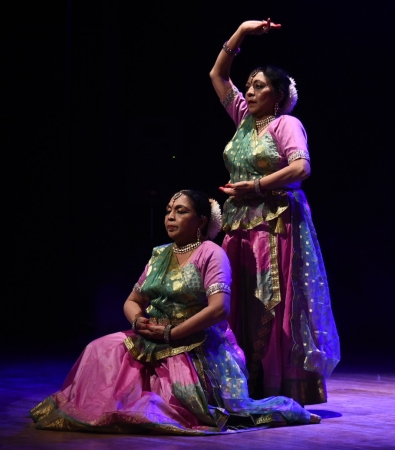 Nalini and Kamalini Asthana The next item was a highly energetic Kathak duet recital by Nalini Asthana and Kamalini Asthana. Nritta and tatkar is their forte and Siva Stuti followed by Pada Sanjoyana involving tala, laya and pada in teentaal was rewarding. The latter item saw some rare combination and permutation of complex beats presented by the two accomplished dancers performing in sync in perfect order showing high level of technical virtuosity. Siva Stuti was embellished with powerful chakkars and footwork with some fine anubhutis and movements of worshipping like pouring water on the Lord's head and making sandalwood paste set to the song "Chandramani lalat bhola". Concluding the evening's presentation was a flute recital by the students of Pt Hariprasad Chaurasia and his Vrindavan Gurukul. The flute maestro rewarded the audience with a short item at the beginning after which his students commenced with raga Marwa and Khilali dhun and concluded with an assortment of ragas and talas. The audience enjoyed and appreciated the flute played by the young students of Vrindavan Gurukul. 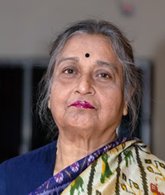 Dr. Nita Vidyarthi is a veteran critic of performing arts and writes on dance, music and theatre in leading publications. |